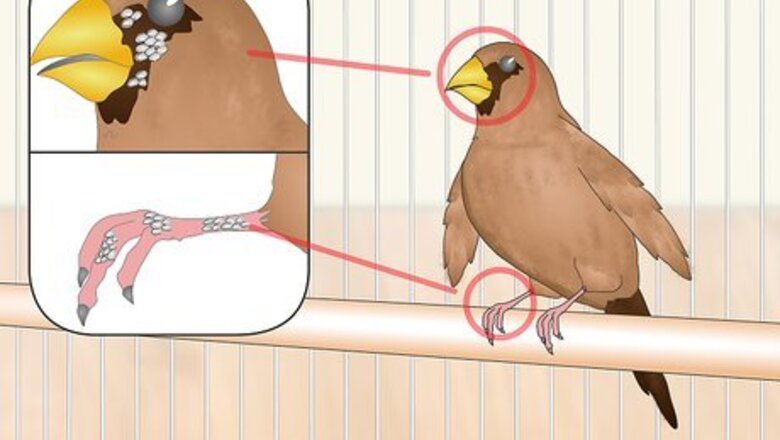
views
Recognizing the Signs of Infestation
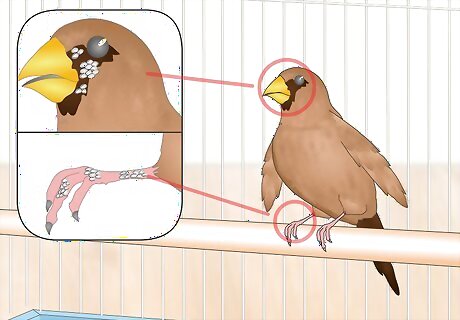
Look for scaly skin on your finches’ legs and faces. One of the most common types of mite infestation in finches is the “scaly leg mite.” These mites infest featherless areas of a bird’s skin, such as the legs and feet, the skin around the beak and eyes, and the cloaca (the opening under the tail where the bird poops). Scaly skin in these areas may be a sign of a mite infestation. These mites cause the skin to take on a scaly, crusty, or honeycomb-like appearance. The scales are usually yellowish in color. An infected finch may develop long “tassels” of deformed scales on their feet. Infected finches may appear restless or have difficulty perching.
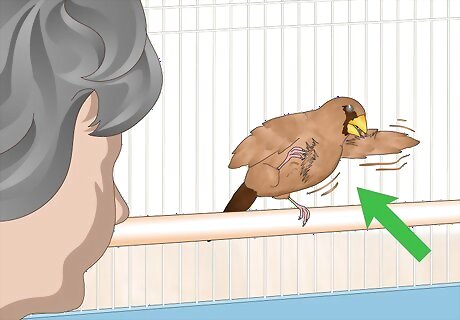
Watch your finches for irritability, itching, and excessive preening. Finches with lice or mites of the feathers and skin will often act restless and uncomfortable. Lice and mites bite and irritate the skin, which can lead to scratching and excessive preening of the feathers. The condition of your finches’ feathers can also be a clue. Lice cause breakage of the feathers, and sometimes baldness. Baldness can also result from a stressed or uncomfortable finch over-preening.
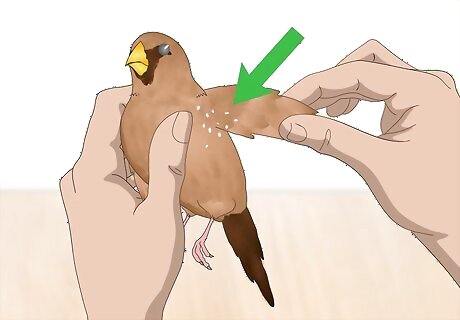
Examine your finches’ skin and feathers for lice. If a finch is infested with lice, you may be able to see the parasites and their eggs on the bird. Catch a finch with a suspected infection and gently lift the feathers with your finger. Look for small white nits (eggs) attached to the lower parts of the feathers, and small, elongated, brown adult lice burrowing through the feathers.

Check your finches for red mites at night. Red bloodsucking mites are nocturnal parasites that hide in nests and other dark areas during the day, then emerge at night to bite their prey. They can be especially dangerous to hatchlings or finches that are sick or elderly. Red mites will appear as tiny, fast-moving brown or red spots on your finches’ skin or feathers. You are unlikely to spot red mites on your birds during the day. As an alternative to inspecting your finches directly, drape a white cloth over the cage at night, and check it for tiny brown or red specks in the morning. Finches infected with red mites may act restless at night. They may also become lethargic or depressed.

Check for respiratory symptoms, if you have Gouldian finches. Gouldian finches are prone to infestation by the host-specific airsac mite. These mites live in the upper respiratory tract of Gouldian finches, including the mouth, nostrils, sinuses, and throat. An untreated infestation of airsac mites can be fatal. The following symptoms may indicate an airsac mite infection in a finch: A whistling or clicking sound during breathing. Breathing with the beak open. Tail-bobbing. Problems with the voice. A finch with airsac mites may lose its voice or suddenly stop singing.
Eliminating Lice and Mites
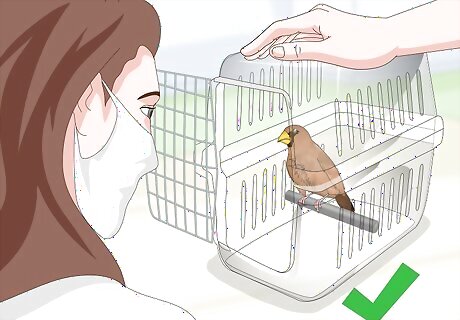
Consult your vet immediately if you suspect an infestation. An avian vet can help you determine the type of parasite infesting your finches, and suggest an appropriate treatment. Depending on the type and seriousness of the infestation, your finches may need to be treated at the vet’s office. For most types of lice and mites, your vet will probably provide a gentle insecticide spray or dust that you can apply at home. Orally or topically administered medications, like ivermectin, are also effective for eliminating a wide variety of parasites. Always follow your vet's instructions for administering these medications. If you have a Gouldian finch infested with airsac mites, your vet may need to administer an injection of anti-parasitic medication.
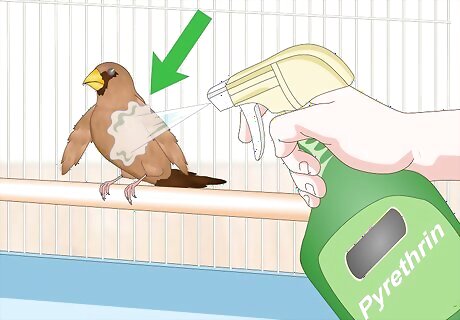
Administer insecticide powders or sprays according to your vet’s instructions. For lice and many types of mites, pyrethrin or carbaryl dust or spray are effective and safe treatments. You may need to repeat the treatment several times in order to eliminate the infestation. For lice, a treatment of pyrethrin or carbaryl should be repeated once every 2-3 weeks in order to eliminate batches of newly hatched lice. Red mites require treatment of both the birds and their cage with pesticide dusts or sprays.

Use topical treatments, if recommended by your vet. In some cases, it may be helpful to apply ointments or pesticide treatments directly to an affected finch’s skin. However, topical medications may be dangerous to your finches, and should only be applied with your vet’s recommendation and instruction. Ivermectin is a medication that can be applied directly to the skin via a dropper, whereupon it enters the bloodstream. Ivermectin can be an effective treatment for lice and most types of mites, including airsac mites. Skin affected by scaly leg mite may be treated with plant oil (to suffocate the mites) and antibiotic creams. However, overuse of topical oils and lotions can be dangerous for birds, as it can affect their ability to regulate their body temperature.
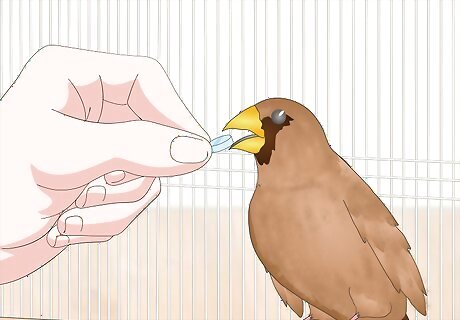
Give oral medications, if prescribed by your vet. Air sac mites and other serious parasitic infestations can often be eliminated with oral treatments. Oral medications are typically added directly to the finches’ drinking water. This can be an especially useful approach if you are trying to treat a large group of birds rather than a single individual.

Thoroughly clean and disinfect your finches’ habitat. When treating external parasites, it is important to eliminate sources of infection in your birds’ environment as well as on the finches themselves. This is especially vital for infestations of red mites, which leave their hosts during the day and hide in nests and other dark areas. Remove all nests and nesting material, perches, and toys, and replace them with new ones after the cage has been cleaned and disinfected. Wash the cage and treat it with bird-safe pesticides (like pyrethrin or carbaryl) every day while your finches are being treated. Dust or spray new nests and perches with bird-safe pesticides before putting them in the cage. Do not spray anything that is in the cage with the finches already.
Preventing Future Outbreaks

Clean your finches’ cage regularly. Even if your finches are currently parasite free, you should keep their environment clean and sanitary. Clean the cage using hot water and either a bird-safe disinfectant or white vinegar. Establish a regular cleaning routine: Wash food and water dishes daily with hot soapy water or white vinegar. Change the paper lining at the bottom of the cage every day. The cage, perches, and accessories should be cleaned and disinfected weekly.

Isolate new birds for observation. Before introducing a new finch to your flock, keep it separate from the rest of the group for at least 60 days. Watch for any signs of illness or parasites. If possible, get the new bird checked by an avian vet before integrating it into the flock.

Allow your finches to bathe every day. Finches are fastidious birds, and they enjoy both grooming and bathing. Provide a shallow water bath for your finches during the day. Remove the bath at night to minimize the risk of drowning, especially if there are chicks or fledglings in the cage. Clean the bath container every day with hot, soapy water, and rinse thoroughly.



















Comments
0 comment